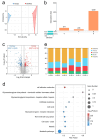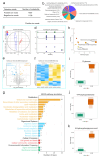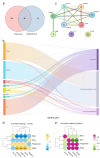Comprehensive Integrated Analyses of Proteins and Metabolites in Equine Seminal Plasma (Horses and Donkeys)
- PMID: 40700277
- PMCID: PMC12285962
- DOI: 10.3390/proteomes13030033
Comprehensive Integrated Analyses of Proteins and Metabolites in Equine Seminal Plasma (Horses and Donkeys)
Abstract
Background: The reproductive ability of equine species is a critical component of equine breeding programs, with sperm quality serving as a primary determinant of reproductive success. In this study, we perform an integrative analysis of proteomics and metabolomics in seminal plasma to identify proteins and metabolites associated with sperm quality and reproductive ability in equine species.
Methods: We utilized the CEROS instrument to assess the morphology and motility of sperm samples from three horses and three donkeys. Additionally, we statistically analyzed the mating frequency and pregnancy rates in both species. Meanwhile, the 4D-DIA high-throughput proteomic and metabolomic profiling of seminal plasma samples from horses and donkeys revealed a complex landscape of proteins and metabolites.
Results: Our findings reveal a certain degree of correlation between seminal plasma proteins and metabolites and sperm quality, as well as overall fertility. Notably, we found that the proteins B3GAT3, XYLT2, CHST14, HS2ST1, GLCE, and HSPG2 in the glycosaminoglycan biosynthesis signaling pathway; the metabolites D-glucose, 4-phosphopantetheine, and 4-hydroxyphenylpyruvic acid in the tyrosine metabolism, starch, and source metabolisms; and pantothenate CoA biosynthesis metabolism present unique characteristics in the seminal plasma of equine species.
Conclusions: This comprehensive approach provides new insights into the molecular mechanisms underlying sperm quality and has identified potential proteins and metabolites that could be used to indicate reproduction ability. The findings from this study could be instrumental in developing novel strategies to enhance equine breeding practices and reproductive management. Future research will focus on exploring their potential for clinical application in the equine industry.
Keywords: donkey; horse; metabolomics; proteomics; seminal plasma; sperm.
Conflict of interest statement
The authors declare no conflicts of interest.
Figures





Similar articles
-
Seminal plasma metabolomics and sperm lipidomics profiles of bull semen with different total progressive motile sperm count.J Anim Sci. 2025 Jan 4;103:skaf012. doi: 10.1093/jas/skaf012. J Anim Sci. 2025. PMID: 39887007
-
Application of seminal plasma to female genital tract prior to embryo transfer in assisted reproductive technology cycles (IVF, ICSI and frozen embryo transfer).Cochrane Database Syst Rev. 2018 Feb 28;2(2):CD011809. doi: 10.1002/14651858.CD011809.pub2. Cochrane Database Syst Rev. 2018. PMID: 29489026 Free PMC article.
-
Methionine supplementation-induced alteration of sheep seminal plasma miRNAs and proteome.J Anim Sci. 2025 Jan 4;103:skaf192. doi: 10.1093/jas/skaf192. J Anim Sci. 2025. PMID: 40495297
-
Can we improve time to patency with vasoepididymostomy with an innovative epididymal occlusion stitch?Int Braz J Urol. 2024 Jul-Aug;50(4):504-506. doi: 10.1590/S1677-5538.IBJU.2024.0222. Int Braz J Urol. 2024. PMID: 38743068 Free PMC article.
-
Antioxidants for male subfertility.Cochrane Database Syst Rev. 2014;(12):CD007411. doi: 10.1002/14651858.CD007411.pub3. Epub 2014 Dec 15. Cochrane Database Syst Rev. 2014. Update in: Cochrane Database Syst Rev. 2019 Mar 14;3:CD007411. doi: 10.1002/14651858.CD007411.pub4. PMID: 25504418 Updated.
References
-
- Parsad R., Bagiyal M., Ahlawat S., Arora R., Gera R., Chhabra P., Sharma U. Unraveling the genetic and physiological potential of donkeys: Insights from genomics, proteomics, and metabolomics approaches. Mamm. Genome Off. J. Int. Mamm. Genome Soc. 2024;36:10–24. doi: 10.1007/s00335-024-10083-y. - DOI - PubMed
Grants and funding
- 32160783/the national natural science foundation regional fund project
- 2024TDZX02/the research projects at Inner Mongolia Agricultural University vocational and technical college
- NJZY23117/the science and technology research projects of universities in Inner Mongolia Autonomous Region
- NDYB2022-42/the research initiation grant program at Inner Mongolia Agricultural University
- BR220402/the basic scientific research operating expenses project of universities directly under the Inner Mongolia Autonomous Region
LinkOut - more resources
Full Text Sources

